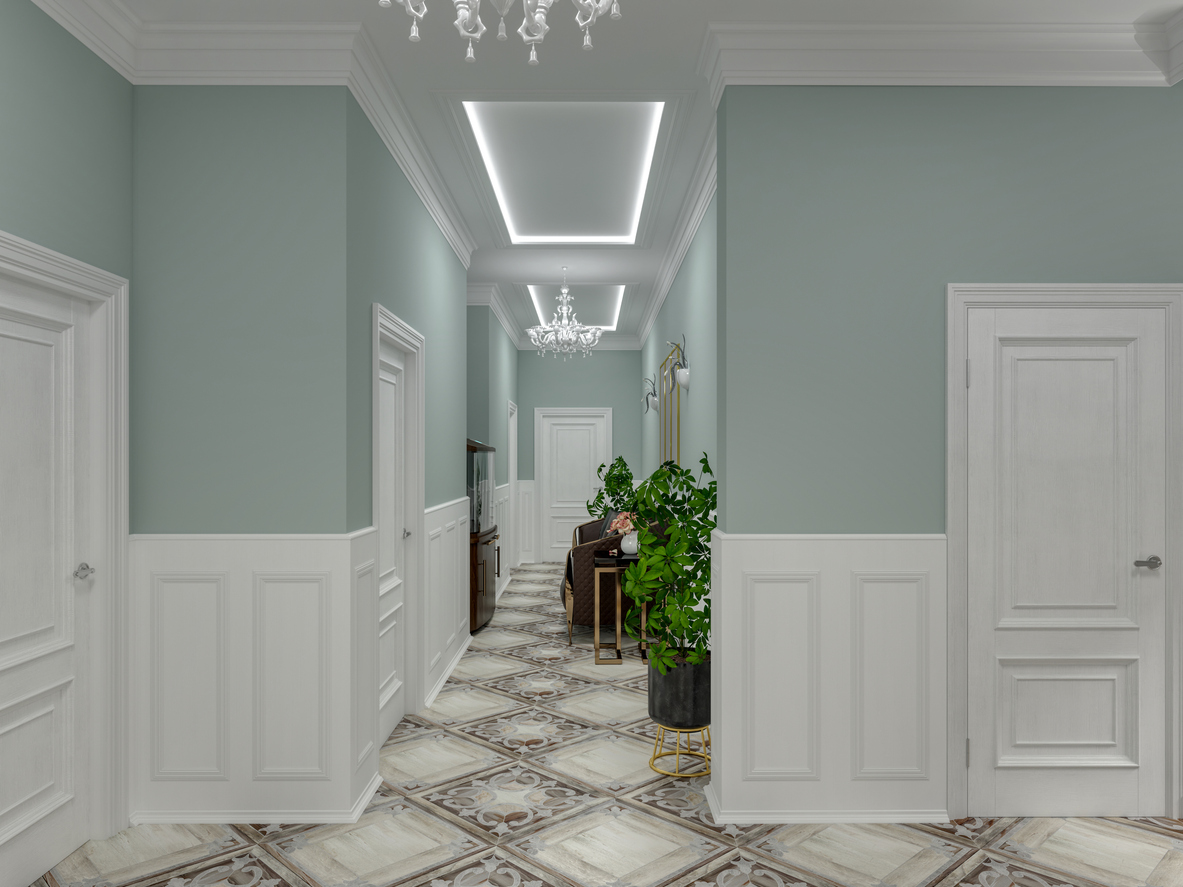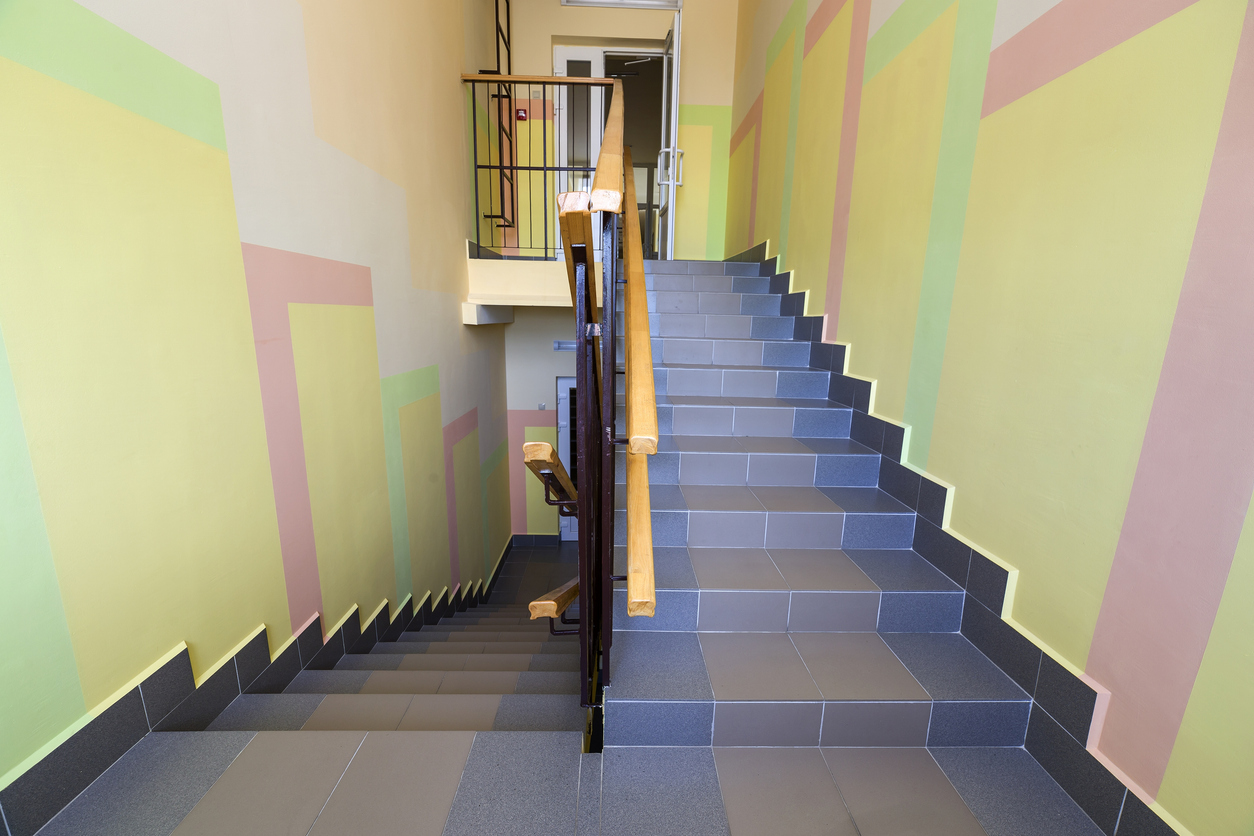When it comes to home design, hallways are often overlooked. Yet, these transitional spaces are the first impression guests have when entering your home. Choosing the right color can transform a hallway from a cold, impersonal corridor into a warm and welcoming space. In this post, we’ll share with you how the right paint choices can make your hallways inviting, setting the tone for the rest of your home.
Choosing Warm Colors
When selecting colors for your hallway, opting for warm tones can instantly create a cozy and inviting atmosphere. Warm colors, such as reds, oranges, and yellows, bring a sense of comfort and energy to a space, making them ideal for areas where you want to welcome and uplift your guests.
Explanation of Warm Colors
Warm colors are hues that remind us of heat and sunlight. They are found on one side of the color wheel and include:
- Reds: These range from bold, vibrant shades to softer, more muted tones. Red is often associated with passion, energy, and warmth.
- Oranges: Orange combines the energy of red with the happiness of yellow, creating a sense of enthusiasm and warmth.
- Yellows: Bright and cheerful, yellow is a color that can evoke feelings of happiness and optimism.
Each of these colors can be used in different ways to suit the style of your home and the effect you want to create in your hallway.
Psychological Effects of Warm Colors in a Hallway
Warm colors do more than just look good; they also have a significant impact on how we feel in a space. Here’s how warm colors can influence the atmosphere of your hallway:
- Creates a Welcoming Environment: Warm tones are inviting, making guests feel comfortable and at ease the moment they step through the door.
- Adds Energy and Vitality: Hallways painted in warm colors can boost energy levels, providing a lively start to the rest of your home.
- Enhances Perception of Space: Warm colors can make a hallway feel cozier without feeling cramped, which is particularly useful in larger, less intimate spaces.
By carefully choosing warm colors for your hallway, you can ensure that this often-overlooked space contributes positively to the overall feel of your home.
Color Combinations and Accents
Creating a warm and welcoming hallway isn’t just about choosing a single color; it’s also about how you combine colors and use accents to enhance the overall effect. By thoughtfully selecting color combinations and adding accents, you can elevate your hallway’s design and create a cohesive, inviting atmosphere.
Suggested Color Combinations for Hallways
Choosing the right color combinations can make your hallway feel more dynamic and visually interesting. Here are a few suggestions:
- Red and Beige: Pairing a warm red with a neutral beige can balance boldness with subtlety, creating a sophisticated and cozy feel. Use the red on an accent wall or as a runner on the floor, and keep the beige on the surrounding walls to soften the look.
- Orange and White: A combination of orange and white can brighten up your hallway while maintaining a warm tone. Orange brings energy, while white adds brightness and a sense of openness. Consider using white on the walls and orange in smaller details, such as artwork, trim, or even a hallway rug.
- Yellow and Gray: Yellow is a cheerful color that pairs well with the cooler tones of gray. This combination can create a balanced, modern look. Use yellow for the walls or ceiling to draw attention, and incorporate gray in furniture or accessories to ground the space.
Tips on Using Accents and Highlights to Enhance the Warmth
Accents and highlights are key to enhancing the warmth of your hallway and adding layers of interest. Here are some tips on how to effectively use them:
- Accent Walls: Painting one wall in a warm, bold color like deep red or burnt orange can make a striking statement. This wall can act as a focal point, drawing the eye and adding depth to your hallway.
- Artwork and Decor: Choose artwork and decorative items that incorporate warm tones. This could include framed prints with warm color palettes, vases in rich hues, or even a collection of baskets that add texture and warmth.
- Lighting: Warm lighting can enhance the colors in your hallway and make the space feel even cozier. Use warm-toned light bulbs and consider wall sconces or a statement chandelier to add both light and warmth.
- Textiles: Rugs, runners, and cushions in warm colors or with warm-toned patterns can add comfort and a welcoming feel. These textiles also help to soften the space and make it more inviting.
By thoughtfully combining colors and incorporating warm accents, you can create a hallway that not only feels inviting but also reflects your personal style.
Lighting and Color
Lighting plays a crucial role in how colors are perceived in any space, including your hallway. The type of lighting you choose can either enhance the warmth of your chosen colors or diminish their effect. Understanding how natural and artificial lighting interacts with color is key to creating a welcoming and visually appealing hallway.
How Natural and Artificial Lighting Affects Color Perception
- Natural Lighting: The amount and direction of natural light in your hallway can dramatically influence how colors appear. In hallways with ample natural light, warm colors like reds, oranges, and yellows will often appear brighter and more vibrant. However, the time of day can also impact the tone of these colors. Morning light, which is cooler, might make warm colors look slightly muted, while afternoon light, which is warmer, will enhance their richness.
- Artificial Lighting: The type of artificial lighting you use can also alter the perception of color. Incandescent and LED bulbs with a warm tone (around 2700K to 3000K on the color temperature scale) tend to enhance warm colors, making them appear more inviting and cozier. On the other hand, cooler lighting (4000K and above) can wash out warm tones, making them appear less vibrant and more subdued.
Understanding these effects is important when planning your hallway’s color scheme. The goal is to ensure that the colors you choose maintain their warmth and appeal, regardless of the lighting conditions.
Tips on Selecting the Right Lighting to Complement Warm Colors
To make the most of your warm color choices, consider the following tips when selecting lighting for your hallway:
- Match Lighting Temperature with Color Tones: Choose light bulbs that complement the warm tones in your hallway. For instance, opt for bulbs with a warm color temperature (2700K to 3000K) to enhance the reds, oranges, and yellows in your space.
- Layer Your Lighting: Use a combination of different light sources to create a balanced and welcoming atmosphere. Ceiling fixtures, wall sconces, and floor lamps can all contribute to the overall warmth of the space. Layering your lighting ensures that your hallway remains inviting during both day and night.
- Consider Dimmers: Installing dimmer switches allows you to adjust the intensity of your lighting according to the time of day and the mood you want to create. Dimming the lights in the evening can enhance the cozy, warm feeling in your hallway.
- Highlight Features with Accent Lighting: Use accent lighting, such as spotlights or wall-mounted fixtures, to highlight specific features like artwork, architectural details, or an accent wall. This not only draws attention to these elements but also adds warmth and depth to the overall space.
By carefully selecting and positioning your lighting, you can ensure that the warm colors in your hallway are shown to their best advantage, creating a welcoming environment that feels just right.
Practical Tips for Painting Hallways
Painting a hallway can be a rewarding project that significantly enhances the look and feel of your home. However, it requires careful preparation and attention to detail to achieve the best results. Here’s a step-by-step guide to help you through the process, along with tips on maintaining your freshly painted hallway to keep it looking vibrant for years to come.
Step-by-Step Guide to Preparing and Painting a Hallway
1. Gather Your Materials: Before you start, make sure you have all the necessary tools and materials. This includes paint, brushes, rollers, painter’s tape, drop cloths, a ladder, and a paint tray.
2. Prepare the Space:
- Clear the Hallway: Remove any furniture, artwork, and fixtures from the hallway. If you can’t move certain items, cover them with a drop cloth to protect them from paint splatters.
- Clean the Walls: Dust and clean the walls to remove any dirt or grease. This helps the paint adhere better. For stubborn spots, use a mild soap solution and a sponge.
- Repair Imperfections: Inspect the walls for cracks, holes, or dents. Fill these with spackling paste, and once dry, sand them smooth for an even surface.
- Tape-Off Areas: Use painter’s tape to cover edges, trim, light switches, and any other areas you don’t want to paint.
3. Prime the Walls: Apply a coat of primer if you’re painting over a dark color or if the walls are new and unpainted. Primer helps the paint adhere better and ensures an even finish.
4. Paint the Ceiling and Trim First: Start with the ceiling if you’re painting it, and then move on to the trim. Use a brush for edges and corners and a roller for larger areas.
5. Cut In the Edges: “Cutting in” refers to painting the edges of the walls where a roller can’t reach, such as along the ceiling, trim, and corners. Use a brush for this task.
6. Roll on the Paint: After cutting in, use a roller to paint the main surfaces of the walls. Apply the paint in a “W” or “M” pattern to ensure even coverage, and then fill in the gaps. Depending on the color and the surface, you may need to apply two coats for a rich, even finish.
7. Let the Paint Dry: Allow the paint to dry completely between coats and after the final coat. Check the paint can for drying times, but generally, it takes about 4-6 hours per coat.
8. Remove Tape and Clean Up: Once the paint is dry, carefully remove the painter’s tape. Clean up any spills or drips immediately with a damp cloth.
Advice on Maintenance and Keeping the Colors Vibrant
Keeping your hallway looking fresh and vibrant requires some ongoing care. Here’s how to maintain your painted hallway:
- Regular Cleaning: Dust and clean the walls regularly using a soft cloth or a duster. For stubborn marks or scuffs, use a mild soap solution and a sponge. Avoid using harsh chemicals, as they can damage the paint.
- Touch-Up Paint: Keep a small amount of the paint you used on hand for touch-ups. Hallways are high-traffic areas, and over time, the paint may get chipped or scratched. A quick touch-up can keep the walls looking fresh.
- Protect the Walls: Consider installing a chair rail or adding washable wall panels to protect the lower portion of the walls from scuffs and dents, especially in busy households.
- Inspect Regularly: Periodically check for any signs of wear, such as fading, cracking, or peeling. Addressing these issues early can prevent more extensive damage and prolong the life of your paint job.
By following these practical tips, you can ensure that your hallway not only looks great immediately after painting but continues to enhance your home’s warmth and welcome for years to come.
Final Thoughts
Transforming your hallway with warm colors and the right techniques can make a big difference in the feel of your home. Whether you’re painting for the first time or refreshing an old look, a well-done hallway can create a welcoming atmosphere for you and your guests.
If you’re ready to give your hallway a fresh, inviting look, Custom Painting, Inc. is here to help. Call us at 925-294-8062 or use our contact form to schedule an appointment. Let us bring warmth and style to your home!



